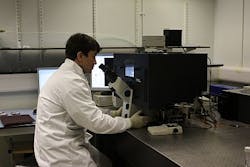Noninvasive Raman microspectroscopy technique boosts stem cell therapy
In stem cell therapy, a problem that exists is controlling the excessive proliferation of cells with unwanted phenotypes after transplantation to prevent tissue overgrowth and tumor formation. And most techniques currently available for characterizing cells are invasive, therefore rendering the cells unusable. Recognizing this, researchers at Nottingham University (Nottingham, England) have developed a noninvasive Raman microspectroscopy (RMS) technique that phenotypically identifies live cardiomyocyte cells within highly heterogeneous cell populations with greater than 96% sensitivity and specificity.
Led by Dr. Ioan Notingher, the team used a back-illuminated CCD camera (from Andor Technology) attached to a purpose-built Raman microspectrometer to record spectra from individual cells derived from micrometric regions of human embryonic stem cells (hESCs). By comparing with matching immunofluorescence images from the same cells, they showed that the Raman spectra correspond to the spatial distribution of biomolecules such as nucleic acids, proteins, lipids and carbohydrates, and that this can be used to discriminate between different cell types.
To yield the shortest possible acquisition times for the Raman spectra, the team's CCD camera enabled measurements of Raman spectra from selected positions in the cells in only 0.5 sec, says Notingher. The camera's detectors work in the 800-900 nm spectral range, thereby avoiding photodamage to the cells. And since RMS has only a minimal background signal from water, it allows repeated observations of viable cells maintained under physiological conditions, he adds.
-----
Subscribe now to Laser Focus World magazine; it's free!
